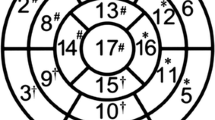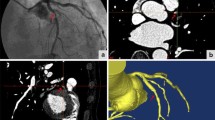Abstract
Purpose
This study was undertaken to evaluate the diagnostic accuracy of computed tomography coronary angiography (CT-CA) for the detection of significant coronary artery stenosis (≥50% lumen reduction) compared with conventional coronary angiography (CCA) in a registry and to review major multicentre trials.
Materials and methods
A total of 1,372 patients (882 men, 490 women; mean age 59.3±11.9 years) in sinus rhythm were studied with CT-CA (64-slice technology) and CCA. The diagnostic accuracy of CT-CA was evaluated against quantitative CCA as a reference standard for coronary artery stenosis. Positive and negative likelihood ratios and inter- and intraobserver agreement were calculated.
Results
The prevalence of disease was 53%. CCA demonstrated the absence of significant coronary artery disease in 46.6% (639/1372), single-vessel disease in 24.7% (337/1372) and multivessel disease in 28.9% (396/1372) of patients. In per-patient analysis sensitivity, specificity and positive and negative predictive value of CT-CA were 99% [confidence interval (CI) 97–99], 92% (CI 89–94), 94% (CI 91–95) and 99% (CI 97–99), respectively. Per-patient and per-segment likelihood ratios (LR+=12.4 and LR−=0.011; LR+=18.3 and LR−=0.064, respectively), were good. Inter- and intraobserver variability was 0.78 and 0.85, respectively.
Conclusions
CT-CA is a reliable diagnostic modality both in terms of sensitivity and negative predictive value. Differences in trial results are also due to the different parameters used for patient inclusion.
Riassunto
Obiettivo
Obiettivo di questo lavoro è stato valutare l’accuratezza diagnostica dell’angiografia coronarica non invasiva con tomografia computerizzata (CT-CA) a 64 strati nell’individuazione delle stenosi coronariche significative (riduzione del lume coronarico ≥50%) confrontata con la coronarografia convenzionale (CAG) in un registro e revisionare i risultati dei trials multicentrici.
Materiali e metodi
Sono stati studiati 1372 pazienti (882 uomini, 490 donne, età media 59,3±11,9 anni) in ritmo cardiaco sinusale con CT-CA (tecnologia 64 strati) e CAG. La CT-CA è stata eseguita secondo i protocolli comunemente utilizzati. L’accuratezza diagnostica è stata calcolata utilizzando la CAG come standard di riferimento. Sono state calcolate l’accuratezza diagnostica, i likelihood ratio positivo e negativo (LR+ e LR−) e la variabilità inter- ed intra-osservatore.
Risultati
La prevalenza di malattia nella popolazione era del 53%. Il 46,6% (639/1372) mostravano coronarie indenni o con lesioni che determinavano stenosi <50%, il 24,7% (337/1372) mostrano malattia critica di un solo vaso, ed il 28,9% (396/1372) dei pazienti mostrava coronaropatia critica multivasale. Nell’analisi per paziente la sensibilità, specificità, valore predittivo positivo e negativo della CT-CA sono risultati 99% (intervallo di confidenza [IC] 97–99), 92% (IC 89–94), 94% (IC 91–95), 99% (IC 97–99), rispettivamente. I likelihood ratio per paziente (LR+=12,4 e LR−=0,011) e per segmento (LR+=18,3 e LR−=0,064), sono risultati ottimali. Le variabilità inter- ed intra-osservatore sono risultate 0,78 e 0,85, rispettivamente.
Conclusioni
La CT-CA è una metodica diagnostica affidabile sia per l’elevata sensibilità che per l’elevato valore predittivo negativo. I risultati dei trials sono variabili anche alla luce dei parametri principali di inclusione utilizzati.
Similar content being viewed by others
References/Bibliografia
Nieman K, Oudkerk M, Rensig BJ et al (2001) Coronary angiography with multislice computed tomography. Lancet 357:599–603
Nieman K, Cademartiri F, Lemos PA et al (2002) Reliable noninvasive coronary angiography with fast submillimeter multislice spiral computed tomography Circulation 106:2051–2054
Mollet NR, Cademartiri F, Nieman K et al (2004) Multislice spiral computed tomography coronary angiography in patients with stable angina pectoris. J Am Coll Cardiol 43:2265–2270
Mollet NR, Cademartiri F, Krestin GP et al (2005) Improved diagnostic accuracy with 16-row multi-slice computed tomography coronary angiography. J Am Coll Cardiol 45:128–132
Mollet NR, Cademartiri F, van Mieghem CA et al (2005) Highresolution spiral computed tomography coronary angiography in patients referred for diagnostic conventional coronary angiography. Circulation 112:2318–2323
Cademartiri F, Runza G, Belgrano M et al (2005) Introduction to coronary imaging with 64-slice computed tomography. Radiol Med (Torino) 110:16–41
Cademartiri F, Luccichenti G, Marano R et al (2003) Spiral CT-angiography with one, four, and sixteen slice scanners. Technical note. Radiol Med (Torino) 106:269–283
Cademartiri F, Luccichenti G, Marano R et al (2003) Non-invasive angiography of the coronary arteries with multislice computed tomography: state of the art and future prospects. Radiol Med (Torino) 106:284–296
Achenbach S, Giesler T, Ropers D et al (2001) Detection of coronary artery stenoses by contrast-enhanced, retrospectively electrocardiographically-gated, multislice spiral computed tomography. Circulation 103:2535–2538
Stolzmann P, Leschka S, Scheffel H et al (2008) Dual-source CT in step-andshoot mode: noninvasive coronary angiography with low radiation dose. Radiology 249:71–80
Scheffel H, Alkadhi H, Leschka S et al (2008) Low-dose CT coronary angiography in the step-and-shoot mode: diagnostic performance. Heart 94:1132–1137
Shuman WP, Branch KR, May JM et al (2008) Prospective versus retrospective ECG gating for 64-detector CT of the coronary arteries: comparison of image quality and patient radiation dose. Radiology 248:431–437
Hirai N, Horiguchi J, Fujioka C et al (2008) Prospective versus retrospective ECG-gated 64-detector coronary CT angiography: assessment of image quality, stenosis, and radiation dose. Radiology 248:424–430
Fox K, Garcia MA, Ardissino D et al (2006) Guidelines on the management of stable angina pectoris: executive summary: the Task Force on the Management of Stable Angina Pectoris of the European Society of Cardiology. Eur Heart J 27:1341–1381
Hendel RC, Patel MR, Kramer CM et al (2008) ACCF/ACR/SCCT/SCMR/ASNC/NAS CI/SCAI/SIR 2006 appropriateness criteria for cardiac computed tomography and cardiac magnetic resonance imaging: a report of the American College of Cardiology Foundation Quality Strategic Directions Committee Appropriateness Criteria Working Group, American College of Radiology, Society of Cardiovascular Computed Tomography, Society for Cardiovascular Magnetic Resonance, American Society of Nuclear Cardiology, North American Society for Cardiac Imaging, Society for Cardiovascular Angiography and Interventions, and Society of Interventional Radiology. J Am Coll Cardiol 48:1475–1497
Schroeder S, Achenbach S, Bengel F et al (2008) Cardiac computed tomography: indications, applications, limitations, and training requirements: report of a Writing Group deployed by the Working Group Nuclear Cardiology and Cardiac CT of the European Society of Cardiology and the European Council of Nuclear Cardiology. Eur Heart J 29:531–556
Bluemke DA, Achenbach S, Budoff M et al (2008) Noninvasive coronary artery imaging: magnetic resonance angiography and multidetector computed tomography angiography: a scientific statement from the american heart association committee on cardiovascular imaging and intervention of the council on cardiovascular radiology and intervention, and the councils on clinical cardiology and cardiovascular disease in the young. Circulation 118:586–606
Marano R, De Cobelli F, Floriani I et al (2009) Italian multicenter, prospective study to evaluate the negative predictive value of 16- and 64-slice MDCT imaging in patients scheduled for coronary angiography (NIMISCAD-Non Invasive Multicenter Italian Study for Coronary Artery Disease). Eur Radiol 19:1114–1123
Budoff MJ, Dowe D, Jollis JG et al (2008) Diagnostic performance of 64- multidetector row coronary computed tomographic angiography for evaluation of coronary artery stenosis in individuals without known coronary artery disease: results from the prospective multicenter ACCURACY (Assessment by Coronary Computed Tomographic Angiography of Individuals Undergoing Invasive Coronary Angiography) trial. J Am Coll Cardiol 52:1724–1732
Miller JM, Dewey M, Vavere AL et al (2009) Coronary CT angiography using 64 detector rows: methods and design of the multi-centre trial CORE-64. Eur Radiol 19:816–828
Meijboom WB, Meijs MF, Schuijf JD et al (2008) Diagnostic accuracy of 64- slice computed tomography coronary angiography: a prospective, multicenter, multivendor study. J Am Coll Cardiol 52:2135–2144
Hausleiter J, Meyer T, Hadamitzky M et al (2007) Non-invasive coronary computed tomographic angiography for patients with suspected coronary artery disease: the Coronary Angiography by Computed Tomography with the Use of a Submillimeter resolution (CACTUS) trial. Eur Heart J 28:3034–3041
Andreini D, Pontone G, Pepi M et al (2007) Diagnostic accuracy of multidetector computed tomography coronary angiography in patients with dilated cardiomyopathy. J Am Coll Cardiol 49:2044–2050
Cademartiri F, Nieman K, van der Lugt A et al (2004) Intravenous contrast material administration at 16-detector row helical CT coronary angiography: test bolus versus bolus-tracking technique. Radiology 233:817–823
Cademartiri F, van der Lugt A, Luccichenti G et al (2002) Parameters affecting bolus geometry in CTA: a review. J Comput Assist Tomogr 26:598–607
Cademartiri F, Luccichenti G, Marano R et al (2004) Use of saline chaser in the intravenous administration of contrast material in non-invasive coronary angiography with 16-row multislice computed tomography. Radiol Med (Torino) 107:497–505
Austen WG, Edwards JE, Frye RL et al (1975) A reporting system on patients evaluated for coronary artery disease. Report of the Ad Hoc Committee for Grading of Coronary Artery Disease, Council on Cardiovascular Surgery, American Heart Association. Circulation 51:5–40
Kim WY, Danias PG, Stuber M et al (2001) Coronary magnetic resonance angiography for the detection of coronary stenosis. N Engl J Med 345:1863–1869
Cademartiri F, Mollet NR, Lemos PA et al (2005) Impact of coronary calcium score on diagnostic accuracy for the detection of significant coronary stenosis with multislice computed tomography angiography. Am J Cardiol 95:1225–1227
Cademartiri F, Runza G, Mollet NR et al (2005) Impact of intravascular enhancement, heart rate, and calcium score on diagnostic accuracy in multislice computed tomography coronary angiography. Radiol Med (Torino) 110:42–51
Leschka S, Alkadhi H, Plass A et al (2005) Accuracy of MSCT coronary angiography with 64-slice technology: first experience. Eur Heart J 26:1482–1487
Ropers D, Rixe J, Anders K et al (2006) Usefulness of multidetector row spiral computed tomography with 64- x 0.6-mm collimation and 330-ms rotation for the noninvasive detection of significant coronary artery stenosis. Am J Cardiol 97:343–348
Pugliese F, Hunink MGM, Gruszczynska K et al (2009) Learning Curve for Coronary CT Angiography: What Constitutes Sufficient Training? (2009) Radiology (in press)
Author information
Authors and Affiliations
Corresponding author
Rights and permissions
About this article
Cite this article
Maffei, E., Palumbo, A., Martini, C. et al. Diagnostic accuracy of 64-slice computed tomography coronary angiography in a large population of patients without revascularisation: registry data and review of multicentre trials. Radiol med 115, 368–384 (2010). https://doi.org/10.1007/s11547-009-0492-5
Received:
Accepted:
Published:
Issue Date:
DOI: https://doi.org/10.1007/s11547-009-0492-5
Keywords
- Multislice computed tomography
- Conventional coronary angiography
- Coronary artery disease
- 64-slice CT
- Registry
- Large population
- Multicentre trials




